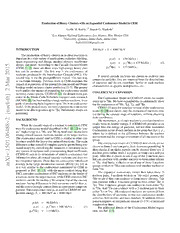
Production of Heavy Clusters with an Expanded Coalescence Model in CEM PDF
Preview Production of Heavy Clusters with an Expanded Coalescence Model in CEM
ProductionofHeavyClusterswithanExpandedCoalescenceModelinCEM LeslieM.Kerby,1,2StepanG.Mashnik1 1LosAlamosNationalLaboratory,LosAlamos,NewMexicoUSA 2UniversityofIdaho,IdahoFalls,IdahoUSA [email protected] INTRODUCTION 300MeV<T <1000MeV Theproductionofheavyclustersinnuclearreactionsis importantinawidevarietyofapplications:radiationshielding, p (d) = 150MeV/c; c space engineering and design, medical physics, accelerator p (t) = p (3He)=175MeV/c; (2) 5 design,andmore. AccordingtotheCascadeExcitonModel c c 1 (CEM) [1, 2], there are three ways high-energy heavy clus- pc(4He) = 175MeV/c. 0 ters can be produced. The first way is via coalescence of 2 nucleonsproducedintheIntraNuclearCascade(INC).The Ifseveralcascadenucleonsarechosentocoalesceinto r second way is via the preequilibrium model. The last way a compositeparticles,theyareremovedfromthedistributions isviaFermibreakup. PreviousworkinCEMexaminesthe M of nucleons and do not contribute further to such nucleon impactofexpansionsofthepreequilibriummodelandFermi characteristicsasspectra,multiplicities,etc. breakupmodelonheavyclusterproduction[3–7]. Thepresent 2 workstudiestheimpactofexpandingthecoalescencemodel COALESCENCEEXPANSION onheavyclusterspectra. CEM03.03[2],thedefaulteventgen- ] h eratorintheMonteCarloN-Particletransportcodeversion6 TheCoalescenceModelinCEM03.03allowsforcoales- -t (MCNP6)[8]forintermediate-energynuclearreactions,isca- cenceupto4He. Wehaveexpandedthistoadditionallyallow cl pableofproducinglightfragmentsupto4Heinitscoalescence forthecoalescenceof6He,6Li,7Li,and7Be. model.Inthepresentstudy,wehaveexpandedthecoalescence u CEM03.03usesthesimplestversionofthecoalescence n modeltobeabletoproduceupto7Be. Preliminaryresultsare model[9,10]andchecksonlythemomentaofnucleonsemit- [ promising. tedduringthecascadestageofreactions, withoutchecking theircoordinates. 2 BACKGROUND Themomentum, p,ofeachnucleoniscalculatedrelativis- v 8 Whenthecascadestageofareactioniscompleted,CEM ticallyfromitskineticenergy,T (CEM03.03providesinits 8 output files the energy of particles, but not their momenta). usesthecoalescencemodeldescribedinRef. [9,10]to“cre- 4 Coalescenceoccursifeachnucleoninthegrouphas|∆p|≤ p , ate”high-energyd,t,3He,and4Hebyfinal-stateinteractions c 6 where ∆p is defined as the difference between the nucleon amongemittedcascadenucleonsoutsideofthetargetnucleus. 0 momentumandtheaveragemomentumofallnucleonsinthe ThecoalescencemodelusedinCEMissimilartoothercoa- 1. lescencemodelsforheavy-ion-inducedreactions. Themain group. 0 differenceisthatinsteadofcomplex-particlespectrabeingesti- ThecoalescencemodelofCEM03.03firstchecksallnu- 5 cleonstoform2-nucleonpairs,theirmomentapermitting. It matedsimplybyconvolvingthemeasuredorcalculatedinclu- 1 sivespectraofnucleonswithcorrespondingfittedcoefficients, then checks if an alpha particle can be formed from two 2- : nucleonpairs(eitherfrom2n-ppairsorfroman-nandp-p v CEM03.03usesinitssimulationsofparticlecoalescencereal pair). Afterthisitcheckstoseeifanyofthe2-nucleonpairs i informationaboutallemittedcascadenucleonsanddoesnot X leftcancombinewithanothernucleontoformeithertritium useintegratedspectra. (Notethatthecoalescenceintroduced r or3He. Andlastly,itcheckstoseeifanyofthese3-nucleon recentlyintheLiègeintranuclearcascade(INCL)[11-14],is a groups(tritiumor3He)cancoalescewithanothernucleonto in a way similar to the coalescence considered by CEM as form4He. proposed in Ref. [9, 10], with the main contrast being that The expanded coalescence model then takes these 2- INCLconsiderscoalescenceofINCnucleonsontheborderof nucleon pairs, 3-nucleon (tritium or 3He only) groups, and anucleus,insidethetarget-nucleus,whileCEMcoalescesINC 4Hetoseeiftheycancoalescetoformheavyclusters. 4He nucleonsoutsidethenucleus.) Weassumethatallthecascade nucleonshavingdifferencesintheirmomentasmallerthan p can coalesce with a 3-nucleon group to form either 7Be or c 7Li. Two 3-nucleon groups can coalesce to form either 6Li andthecorrectisotopiccontentformanappropriatecomposite or6He. And4Hecancoalescewitha2-nucleonpairtoform particle. Thecoalescenceradii p asusedinCEM03.03are: c either6Lior6He. Allcoalescednucleonsareremovedfrom Incidentenergy,T,<300MeVor>1000MeV thedistributionsofnucleonssothatourcoalescencemodel conservesbothatomic-andmass-numbers.Inaddition,thisex- p (d) = 90MeV/c; pansionrequiresaninsignificantamount(2–3%)ofincreased c computationtime. pc(t) = pc(3He)=108MeV/c; (1) ForadditionaldetailsoftheCoalescenceModelexpan- p (4He) = 115MeV/c. sion,seeRef.[15]. c CoalescenceParameter p low- and moderate-energy, thus improving agreement with c experimentaldataintheseenergyregionsaswell. Asmentionedabove, pc determineshowdissimilarthe Fig.3displaysexperimentalresultsofthereaction480 momenta of nucleons can be and still coalesce. pc was ex- MeV p + natAg → 6Li by Green et al. [17] (green circles), panded to also include a value for heavy clusters, or light compared with simulations from results from CEM03.03F fragments(LF): pc(LF). Ournew pc’sforincidentenergies, withoutcoalescenceexpansion(bluesolidlines),CEM03.03F T,lessthan300MeVorgreaterthan1000MeVare: withcoalescenceexpansion(reddashedlines),andtheorig- inal CEM03.03 (brown dashed-dotted lines). Even without pc(d) = 90MeV/c; the coalescence expansion, CEM03.03F (which contains a p (t) = p (3He)=108MeV/c; (3) preequilibriumexpansionandatotalreactioncrosssectionim- c c p (4He) = 130MeV/c. provement)yieldsmuchbetterresultsthanCEM03.03without c anyoftheseimprovements.Addingthecoalescenceexpansion p (LF) = 175MeV/c. c producesevenbetterresults. Similarresultsformanyotherreactionsinducedbypro- Andfor300MeV<T <1000MeV tons, neutrons, and heavy ions (the last are simulated with LAQGSM03.03[2],butwithanextendedcoalescencemodel p (d) = 150MeV/c; c asdescribedinRef. [18])andfurtherdiscussionscanbefind pc(t) = pc(3He)=175MeV/c; (4) inRefs.[15,18]. p (4He) = 205MeV/c. c p (LF) = 250MeV/c. c Note that the p (4He) was also increased compared to c the old p values. Too many alpha particles were lost (coa- c lescedintoheavyclusters),andthereforewecompensatedby increasingthecoalescenceof4He. RESULTSANDANALYSIS Examples of results of our coalescence expansion are displayedinFigs.1–3. TheupgradedCEM03.03Fwithout coalescence expansion (blue solid lines) and the upgraded CEM03.03Fwithcoalescenceexpansion(reddashedlines) are compared with experimental data (green circles). This coalescenceexpansionanalysisispartofalargerproject[3–7] aimedatproducinghigh-energylightfragmentsinspallation reactions.CEM03.03FreferstotheupgradedCEM03.03code, whichhasbeenupgradedwithaModified-Exciton-Modelex- pansionandatotalreactioncrosssectionmodelimprovement. Thebluesolidlinescontainbothoftheseimprovementsover theoriginalCEM03.03,andthereddashedlinescontainboth oftheseimprovementsplusthecoalescenceexpansion. Fig.1displaysfragmentproductionspectraof6Heand 6Liforthereaction1200MeVp+197Au. Experimentaldata byBudzanowskietal. [16](greencircles)arecomparedwith resultsfromCEM03.03Fwithoutcoalescenceexpansion(blue solidlines)andCEM03.03Fwithcoalescenceexpansion(red dashedlines). Thecoalescenceexpansionincreasesthepro- ductionofhigh-energy6Heand6Li,andimprovesagreement withexperimentaldata. Fig. 2 displays the fragment production spectra of 7Li and7Beforthereaction480MeVp+natAg. Experimental databyGreenetal. [17](greencircles)arecomparedwith Fig.1. ComparisonofexperimentaldatabyBudzanowski,et resultsfromCEM03.03Fwithoutcoalescenceexpansion(blue solidlines)andCEM03.03Fwithcoalescenceexpansion(red al. [16](greencircles)fortheproductionof6Heand6Liat dashedlines). Again,thecoalescenceexpansionincreasesthe anangleof20◦fromthereaction1200MeVp+197Au,with productionofheavyclusters,andimprovesagreementwith resultsfromCEM03.03Fwithoutcoalescenceexpansion(blue experimentaldata. solidlines)andCEM03.03Fwithcoalescenceexpansion(red Thesereactionsalsohighlighthowthecoalescencecan dashedlines). produce heavy clusters not just of high-energy, but also of opportunitytostudywithsomeoftheworld’sgreatestex- pertsinnuclearphysics,particularlyhigh-energyphysics. 3. Dr. AkiraTokuhiro,forhiscontinuedsupportandexper- tiseinservingasmythesisadvisor. ThisstudywascarriedoutundertheauspicesoftheNa- tionalNuclearSecurityAdministrationoftheU.S.Department ofEnergyatLosAlamosNationalLaboratoryunderContract No. DE-AC52-06NA25396. This work is supported in part (for L.M.K.) by the M. HildredBlewettFellowshipoftheAmericanPhysicalSociety, www.aps.org. REFERENCES 1. K.GUDIMA,S.MASHNIK,andV.TONEEV, “Cascade- ExcitonModelofNuclearReactions,” NuclearPhysics, A401,329,(1983). 2. S. MASHNIK, K. GUDIMA, R. PRAEL, A. SIERK, M. BAZNAT, and N. MOKHOV, “CEM03.03 and LAQGSM03.03EventGeneratorsfortheMCNP6,MC- NPX, and MARS15 Transport Codes,” Invited lectures presentedattheJointICTP-IAEAAdvancedWorkshop onModelCodesforSpallationReactions,February4–8, 2008,ICTP,Trieste,Italy,LA-UR-08-2931,LosAlamos (2008);E-print: arXiv:0805.0751v2. 3. L.KERBY,S.MASHNIK, “TotalReactionCrossSec- tionsinCEMandMCNP6atIntermediateEnergies,” sub- mittedtoNucl.Instr.Meth.B,LANLReport,LA-UR-14- 29371,(2014). Fig.2. ComparisonofexperimentaldatabyGreenetal. [17] 4. L. KERBY, S. MASHNIK, “LANL Fiscal Year 2014 (green circles) for the production of 7Li and 7Be at an an- Report,” LANLReportLA-UR-14-27533,LosAlamos gle of 40◦ from the reaction 480 MeV p + natAg, with re- (2014);http://www.osti.gov/scitech/biblio/1162152. sultsfromCEM03.03Fwithoutcoalescenceexpansion(blue solidlines)andCEM03.03Fwithcoalescenceexpansion(red 5. S. MASHNIK, L. KERBY, “MCNP6 Fragmentation of Light Nuclei at Intermediate Energies,” Nuclear In- dashedlines). strumentsandMethodsinPhysicsResearchA,764,59, CONCLUSIONS (2014);arXiv:1404.7820. Expanding the coalescence model within CEM yields 6. L.KERBY,S.MASHNIK,andA.TOKUHIRO, “Produc- increasedproductionofheavyclustersinnuclearspallation tionofEnergeticLightFragmentswithExpandedCascade reactions,particularlyinthehigh-energyregion,butalsoin ExcitonModel(CEM),” TransactionsoftheAmerican thelow-andmoderate-energyregions. Preliminaryresultsin- NuclearSociety,110,465,(2014). dicatethiscoalescenceexpansionyieldsimprovedagreement withexperimentaldata. Weplantoimplementtheseupgrades 7. L. KERBY, S. MASHNIK, and A. SIERK, “Pree- intoMCNP6. quilibrium Emission of Light Fragments in Spallation Reactions,” Nuclear Data Sheets, 118, 316, (2014); ACKNOWLEDGMENTS arXiv:1303.4311. Oneofus(LMK)isgratefulto 8. T.GOORLEY,etal., “InitialMCNP6ReleaseOverview, MCNP6 version 0.1,” Nuclear Technology, 180, 298, 1. Dr.StepanMashnik,forhiscontinuedmentoringandam- (2012). pletechnicalandscientificsupportandencouragement; 9. V.TONEEV,K.GUDIMA, “ParticleEmissioninLight 2. Drs. AvneetSood,LarryCox,ForrestBrown,andTim andHeavyIonReactions,” NuclearPhysics,A400,173c, Goorley and Los Alamos National Laboratory for the (1983). Fig.3. Comparisonofexperimentalresultsofthereaction480MeVp+natAg→6Liat60◦byGreenetal. [17](greencircles), withsimulationsfromtheoriginalCEM03.03(browndashed-dottedlines),CEM03.03Fwithoutcoalescenceexpansion(blue solidlines)andtheCEM03.03Fwithcoalescenceexpansion(reddashedlines). 10. H.SCHULZ,G.RÖPKE,K.GUDIMA,andV.TONEEV, 15. L.KERBY,S.MASHNIK, “AnExpandedCoalescence “TheCoalescencePhenomenonandthePauliQuenching ModelwithintheIntraNuclearCascadeofCEM,” LANL inHigh-EnergyHeavyIonCollisions," PhysicsLetters, Report,LA-UR-15-20322. 134B,458,(1983). 16. A.BUDZANOWSKI,etal.,“CompetitionofCoalescence 11. J.CUGNON,etal., “ProductionofHeavyClusters(up and“Fireball”ProcessesinNonequilibriumEmissionof toA=10)byCoalescenceDuringtheIntraNuclearCas- LightChargedParticlesfrom p+AuCollisions,” Physical cadePhaseofSpallationReactions,” JournalofPhysics: ReviewC,78,024603,(2008). ConferenceSeries,312,082019,(2011). 17. R. GREEN, R. KORTELING, and K. JACKSON, “In- 12. A.BOUDARD,etal., “NewPotentialitiesoftheLiègeIn- clusiveProductionofIsotopicallyResolvedLiThrough traNuclearCascade(INCL)ModelforReactionsInduced MgFragmentsby480MeVp+AgReactions,” Physical byNucleonsandLightChargedParticles,” PhysicalRe- ReviewC,29,1806,(1984). viewC,87,014606,(2013). 18. S.MASHNIK,L.KERBY,andK.GUDIMA,“Fragmen- 13. S. LERAY, et al., “Recent Developments of the Liège tationofLightNucleiatIntermediateEnergiesSimulated IntranuclearCascadeModelinViewofitsUseintoHigh- with MCNP6," LANL Report LA-UR-15-20953, to be energyTransportCodes,” NuclearDataSheets,118,312, presented at the Fifth International Conference on Nu- (2014). clearFragmentationFromBasicResearchtoApplications (NUFRA2015),4–11October2015,Kemer,Turkey. 14. D. MANCUSI, et al., “Extension of the Liège Intranuclear-Cascade Model to Reactions Induced by LightNuclei,” PhysicalReviewC,90,054602,(2014).
